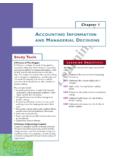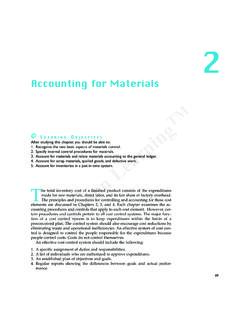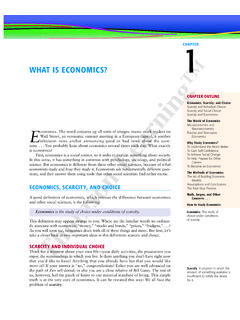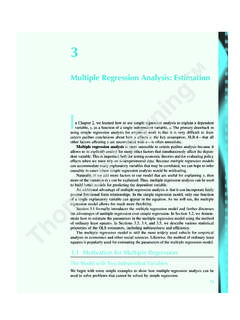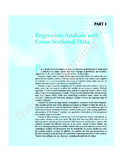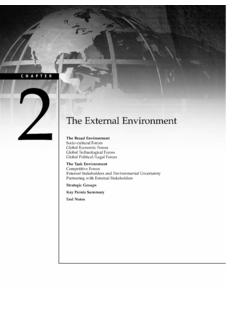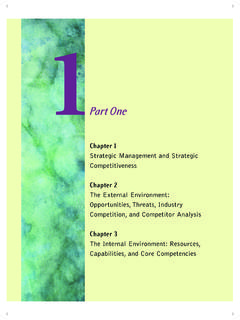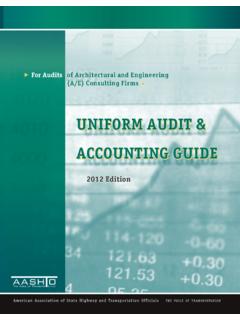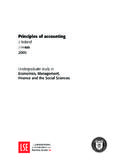Transcription of OIL AND GAS ACCOUNTING
1 555 CHAPTER15 OIL AND GAS ACCOUNTINGLEARNING OBJECTIVESA fter reading this chapter, you should be able to: Understand the nature of full cost (FC) and successful efforts (SE) ACCOUNTING . Grasp the background and politics of standard setting for oil andgas ACCOUNTING . Understand the SEC s reserve recognition ACCOUNTING (RRA) pro-posal. Understand SFAS No. 69 and its relationship to and gas ACCOUNTING is an interesting though specialized area,one that demonstrates many theoretical problems of the typediscussed in this book. Standard setting in this area has beenthe subject of controversy for nearly two decades. Moreover, several ofthe decisions rendered by standard-setting agencies have been ex-tremely dubious. From a theoretical point of view, financial accountingand reporting in the oil and gas industry illustrates very well a situationin which information produced by the historical cost model generally isconsidered to be much less relevant for decision makers than infor-mation produced by some form of current valuation.
2 Because of this fac-tor and the politics of the oil and gas ACCOUNTING controversy, we haveseen more empirical research using security price movements to ascer-tain the economic impact of an ACCOUNTING standard in this area than inany other single area of this chapter we first look at an example of the impact on financialstatements of full cost (FC) versus successful efforts (SE) ACCOUNTING (thetwo broad methods of applying historical cost). Then we take up a dis-cussion of the conceptual differences between the two methods in the ap-plication of historical costing. We also review standard setting for oil 6/8/2000 10:21 AM Page 555556 Chapter 15 Oil and Gas Accountinggas ACCOUNTING and the various empirical studies, compare oil and gasaccounting to the conceptual framework, and examine the current valueapproach proposed by the Securities and Exchange Commission that wascalled reserve recognition ACCOUNTING (RRA). Last, we take up the currentstatus of financial ACCOUNTING and reporting in the oil and gas practice, there are variations in the application of both FC and SEbecause of such factors as the definition of a cost center (to be discussedlater).
3 However, in this chapter the two methods will be examined intheir broadest sense. The basic difference between the two is their treat-ment of incurred exploration costs that do not result in the discovery ofoil or gas reserves. Under FC, all the costs of exploration are capitalized,regardless of whether those costs lead to a specific discovery of rationale supporting FC is the probabilistic nature of exploration: itmay require, on average, that numerous exploratory wells be drilled inorder to find a reservoir that can be developed. Therefore, costs of all ex-ploration are included in the cost of successful wells. Under SE, only theexploration costs that result in a producing well are capitalized; explo-ration costs that result in dry holes are expensed immediately. If fourexploratory wells are drilled and three are dry holes, the costs of thosethree will not provide future benefits and therefore should be following example will illustrate the possible impact on financialstatements of applying FC versus SE for a relatively young Corporation was formed three years ago and has drilled four ex-ploratory wells per year with a success rate of 25 percent.
4 Depletion ex-pense is 20 percent of beginning-of-year oil properties (that is, XYZ pro-duces 20 percent of its proven reserves each year), and depreciationexpense is 10 percent of beginning-of-year other assets. Production costis 8 percent of revenues. In the current year, 100,000 barrels of oil weresold at $32 per barrel. Four exploratory wells were drilled at an averagecost of $525,000. One well was successful. Exhibit 15-1 presents the be-ginning-of-year balance sheets, 15-2 the current-year income state-ments, and 15-3 the end-of-year balance sheets under both the FC andSE the illustration is hypothetical, it does point out that the twomethods may have a significant impact on financial statements, particu-larly for a relatively new or developing enterprise. In this illustration, as-sets differ by $ million, or approximately 54 percent (FC as base) atyear end. The difference is even more pronounced in stockholders eq-uity, where SE s stockholders equity is only 24 percent of FC s.
5 Net in-come varied by $843,000, or 45 results appear unusually large; however, the potential effectsare substantiated by several studies of the financial statements of oper-ating enterprises. For example, in a study of 28 enterprises, Klingstedt 6/8/2000 10:21 AM Page 556 Chapter 15 Oil and Gas Accounting557 EXHIBIT 15-1 XYZ Corporation Balance Sheets, Beginning of YearFCSEA ssetsCurrent assets$ 800,000$ 800,000 Oil properties4,880,0001,220,000 Other assets1,000,0001,000,000 Total$6,680,000$ 3,020,000 Liabilities and Stockholders EquityCurrent liabilities$ 600,000$ 600,000 Long-term liabilities2,000,0002,000,000 Common stock2,000,0002,000,000 Retained earnings (Deficit)2,080,000(1,580,000)Total$6,680 ,000$ 3,020,000 EXHIBIT 15-2 XYZ Corporation Income Statements, Current YearFCSER evenues (100,000 barrels at $32)$3,200,000$ 3,200,000 Expenses:Production costs$ 256,000$ 256,000 Depletion976,000244,000 Depreciation100,000100,000 Exploration costs 1,575,000$1,332,000$ 2,175,000 Net Income$1,868,000$ 1,025,000data revealed that earnings may increase from 10 percent to several hun-dred percent by merely switching from the SE method to the Ross & Company (now Deloitte and Touche) found in astudy of 36 enterprises that net income would be reduced by 20 percent,assets by 30 percent, and stockholders equity by 16 percent if the en-terprises were required to switch from FC to , the FirstBoston Corporation s analysis showed net income reductions as high as1 Klingstedt (1970, pp.)
6 79 86).2 Touche Ross & Co. (1977). 6/8/2000 10:21 AM Page 55755 percent as a result of switching from FC to Financial Ac-counting Standards Board staff found similar but smaller variations in astudy of its DIFFERENCES BETWEEN FC AND SEBoth FC and SE methods of ACCOUNTING in the oil and gas industry areallowed under generally accepted ACCOUNTING principles . The fundamen-tal difference between FC and SE is the size of the cost center used inthe capitalize/expense decision for exploration costs. Under FC, thelargest possible cost center is the country or even a continent, and allcosts of finding oil and gas reserves would be capitalized regardless ofwhether a specific local effort is successful. Under SE, the smallest pos-sible cost center is the property (lease), reservoir, or field (most SE com-panies use the field), and all costs of that well would be expensed unlessoil and gas reserves are found. Establishing a direct cause-and-effect re-lationship between costs incurred and reserves discovered is not rele-vant to recording the costs as assets under FC, while such a relationshipmust exist to record the costs as assets under SE.
7 Both methods eventu-ally will produce the same ACCOUNTING results because the same costs areincurred and the same discoveries made. The timing of those results,558 Chapter 15 Oil and Gas AccountingEXHIBIT 15-3 XYZ Corporation Balance Sheets, End of YearFCSEA ssetsCurrent assets$1,445,000$ 1,445,000 Oil properties6,004,0001,501,000 Other assets900,000900,000 Total$8,349,000$ 3,846,000 Liabilities and Stockholders EquityCurrent liabilities$ 401,000$ 401,000 Long-term liabilities2,000,0002,000,000 Common stock2,000,0002,000,000 Retained earnings (Deficit)3,948,000(555,000)Total$8,349,0 00$ 3,846,0003 First Boston Corporation (1978).4 FASB (1978). 6/8/2000 10:21 AM Page 558however, may vary significantly. Notice that SE embodies finite unifor-mity: if exploration is unsuccessful, exploration costs are expensed; how-ever, when successful exploration occurs, costs are ACCOUNTING was the only method used prior to the late 1950s andearly 1960s. About that time, FC came into use, and by the late 1960s itwas widely used.
8 A reason suggested for the increase in the use of theFC method was problems with the application of the historical the oil and gas industry, amounts spent on exploration haveno predictable relationship to the value of oil and gas discovered. For ex-ample, a large amount may be spent to find nothing, but in another geo-graphical area a small amount spent could result in a large motivation for FC was frustration with a historical cost concept thatpenalizes enterprises for exploration efforts that result in no discoveriesand does not reward those efforts that result in discoveries with recogni-tion of the value discovered. Although FC does not accomplish the lattergoal, it does accomplish the former by capitalizing all exploration costsas long as discovery values exceed costs on a company-wide of the theoretical reason(s) for its increasing use, FC doeshave a desirable impact on reported income, not to mention net assets ofgrowing firms as illustrated in Exhibits 15-1, 2, and 3.
9 FC also results ina smoothing of reported income because costs that are written off in thecurrent period under the SE method are capitalized and amortizedagainst revenues of a number of future periods. Generally, the larger,more mature and fully integrated enterprises in the oil and gas industryuse SE, while the smaller, less integrated enterprises use FC. In usingFC, the larger enterprises, simply because of their size and the extent oftheir operations, would receive a relatively smaller smoothing impactthan the smaller enterprises. A 1973 survey of approximately 300 enter-prises found that nearly one-half used , a 1972 surveyfound that SE enterprises were responsible for 87 percent of the oil andgas produced in the United later survey, in 1977, found thatonly 6 percent of the oil and gas produced in the United States andCanada came from enterprises using the FC flexibility, with either FC or SE being permissible, caused theFASB to reconsider whether either method of ACCOUNTING was appropriate:Neither full costing nor successful efforts costing reflects success at thetime of discovery.
10 Under both methods, success is reported at the time ofChapter 15 Oil and Gas Accounting5595 Arthur Young (1977, p. 5).6 Ginsburg, Feldman, and Bress (1973, p. 31).7 Porter (1972, p. 6).8 Arthur Young (1977, p. 4). 6/8/2000 10:21 AM Page 559sale. It might be said, therefore, that both methods tend to obscure, or atleast delay, the reporting of success, but that is the consequence of thehistorical cost basis of ACCOUNTING , and its adherence to the only is the sale basis of revenue recognition questionable in theoil and gas industry, but the use of acquisition cost as a measure of eco-nomic value is gravely deficient. Under the historical cost model, at thetime an asset is purchased the value to the purchaser is normally as-sumed to be measured by the cost. Both SE and FC, although they differsignificantly in their treatment of costs, present as assets only the costsincurred in exploration and development. Those costs typically do nothave any relationship whatsoever to the economic resources of these problems and the political concern in the United Statesregarding the compilation of meaningful information on domestic oil andgas reserves, standard-setting bodies have struggled with oil and gas ac-counting for several SETTING FOR OIL AND GAS ACCOUNTINGF inancial ACCOUNTING and reporting for the oil and gas industry has beenstudied by standard setters for a long time.
